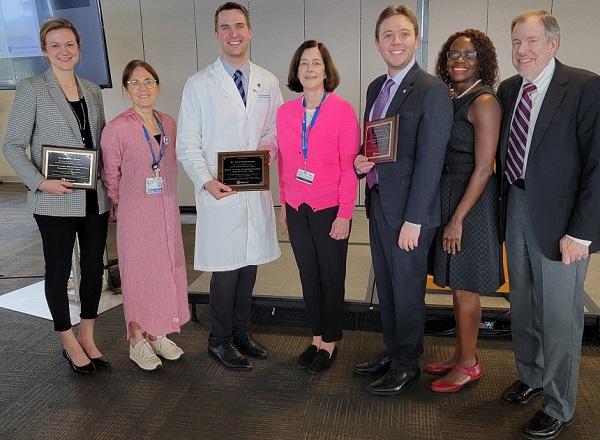
The Department of Medicine’s 2024 Resident Research Day, held Friday, May 10, featured presentations from this year’s Califf Resident Research Award winners: Drs. Isabelle Byers, PGY-2, Noah Hellermann, PGY-2, and Jay Lusk, PGY-1.
The presentations were followed by a poster presentation featuring 20 entrants. The winning posters will be announced during Medicine Grand Rounds on Friday, May 17, 2024. (See the complete list of poster submissions and the Stead Resident Research Grant winners,)
Meet the 2024 Califf Resident Research Award winners:

Isabelle Byers, MD
PGY-2, Internal Medicine
Project: Care Coordination for Patients Admitted with Alcohol-Associated Liver Disease: An Assessment of Appropriate Follow-up and Treatment at Time of Discharge
Mentor: Stephanie Garbarino, MD
Alcohol use disorder (AUD) and alcohol-associated liver disease (ALD) are on the rise in the United States. Effective management of ALD needs a multidisciplinary approach and coordination of services across specialties.
Dr. Byers' work highlights a significant gap in care delivery for this patient population, and identifies a critical need to establish quality measures for the inpatient management and long-term follow-up of alcohol-related liver disease.
Her study assesses whether patients hospitalized ALD and AUD have access to appropriate provider follow-up and treatment at the time of discharge, and to identify modifiable factors that enable care coordination.
She looked at Duke University Medical Center admissions for adults with ALD and AUD for a one-year period in 2022, defining ALD and AUD patients by ICD-10 codes. In 16% of admissions, patients attended a hepatology appointment within 90 days of discharge. In 4% of admissions, patients were referred to a behavioral health provider. In 14% of admissions, patients were prescribed AUD medication.
In the study population, rates of specialist follow-up and treatment for AUD and ALD after a hospital admission were overall low. Among modifiable risk factors, involvement of hepatology and social work teams during hospitalization significantly improved care coordination for patients at discharge.

Noah Hellermann, MD
PGY-2, Internal Medicine-Pediatrics Residency
Readiness for Pediatric to Adult Healthcare Transition in Young Adult Hospitalized Patients
Mentor: Ruchi Doshi, MD, MPH
Young adults with childhood onset chronic conditions (COCC) are at risk for deteriorations in health when transitioning from pediatric to adult healthcare. Dr. Hellermann performed a retrospective chart review of young adults with COCC admitted to general medicine wards in 2023 in order to characterize patients with poor readiness for healthcare transition (HCT).
He evaluated patients with the Transition Readiness Assessment Questionnaire (TRAQ), a validated 20 item tool that assesses self-reported transition readiness skills. A majority (81%) of the surveyed young adults declared readiness for HCT.
However, two distinct groups had low readiness to transition. The first group included patients with significant intellectual and developmental disabilities. For these patients, further assessments are needed, specifically focused on the legal and logistical challenges associated with transitioning care for dependent young adults.
A second group of patients had chronic conditions that didn’t cause developmental disability. These patients had significantly higher rates of unmet health related social needs.
“We hypothesize that these unmet needs lowered TRAQ scores,” Dr. Hellermann said. “Interventions targeted at barriers such as a lack of transportation, unstable housing, or medication cost may be particularly effective in these patients.”

Jay Lusk, MD
PGY-1, Internal Medicine
Neighborhood Socioeconomic Deprivation, Healthcare Access, Characteristics of Treating Healthcare Facilities, and 30-day Mortality and Readmission for Patients Hospitalized with Common Medical Conditions
Mentor: Bradley G. Hamill, DrPH
Prior studies have associated neighborhood characteristics with health outcomes but have been limited by studying narrow geographic populations, lack of adjustment for medical risk, and lack of attention to health systems factors.
Dr. Lusk evaluated the association between neighborhood socioeconomic deprivation and 30-day mortality and readmission for patients hospitalized with common medical conditions after accounting for these factors.
Utilizing nationwide United States Medicare claims from 2016-2019, hospitalizations were categorized by Diagnosis Related Groups (DRGs), which capture the principal reason for admission. Neighborhood socioeconomic deprivation was assessed using the Area Deprivation Index (ADI), an established measure calculated at the level of census block groups.
He adjusted for individual factors such as age, race/ethnicity, medical comorbidity burden, and individual poverty, access to healthcare (number of primary care providers, specialists, and hospital beds per capita), and characteristics of treating hospitals (number of beds, ownership, and teaching status). Generalized estimating equations were used to estimate logistic regression models to account for within-hospital clustering.
A total of 6,556,790 admissions were eligible for the mortality cohort and 6,340,710 were eligible for the readmission’s cohort. Across a variety of conditions, there was a consistently strong association between neighborhood socioeconomic status and 30-day mortality after adjustment for individual factors, access to healthcare, and characteristics of treating facilities; e.g. for patients admitted with heart failure, living in a low SES neighborhood was associated with increased risk of mortality.
“Neighborhood socioeconomic deprivation is independently associated with unfavorable post-hospitalization outcomes across a range of medical conditions, and this association is not explained by decreased access to care or characteristics of treating hospitals,” Dr. Lusk said.